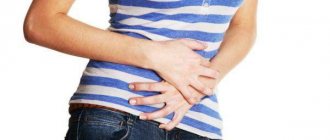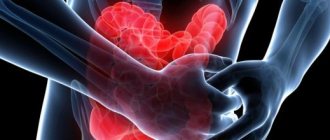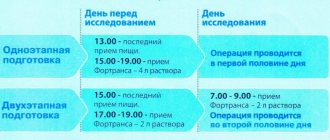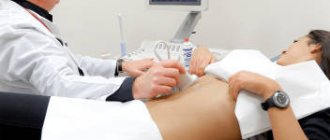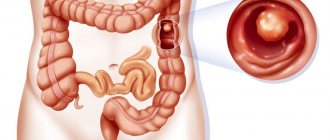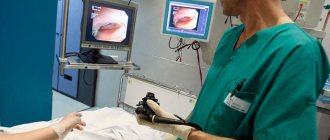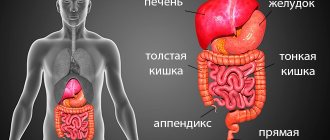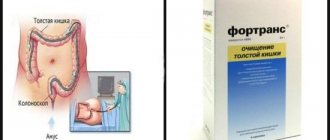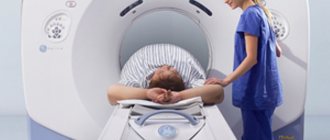To identify or exclude diseases of the large intestine, the presence of tumors, colitis and polyps, a non-invasive diagnostic method is used - irrigoscopy. By studying the X-ray images obtained, specialists analyze the functional state of the intestines.
Irrigoscopy of the intestine
Preparation for the procedure is necessary to obtain reliable data, high-quality and informative research. If the intestines are clogged with feces, the result will not be reliable.
Irrigoscopy: preparation for examination
Who is the procedure indicated for?
The patient may be referred for irrigoscopy if it is not possible to perform a colonoscopy of the intestine. In addition, the procedure is performed for people suffering from:
- frequent constipation or diarrhea;
- bleeding during bowel movements, especially with discharge of pus and mucus;
- pain and discomfort in the anal area.
Irrigoscopy is indicated for diagnosed fistulas, Crohn's disease, ulcerative colitis, diverticulosis, and suspected cancer.
Irrigoscopy will help determine the shape and taper of the colon, as well as how it moves over time.
Question answer
How long does irrigoscopy take and can it be performed through a stoma (colostomy)?
The procedure takes from a quarter of an hour to 45 minutes. The research method is similar to conventional irrigoscopy; it is performed in the presence of a colostomy on the anterior abdominal wall.
What kind of nutrition should you have after irrigoscopy?
After irrigoscopy, it is advisable to eat foods that are gentle on the digestive canal. Puree soups, weak broths, vegetable and slimy soups, jelly, and liquid porridges will be useful.
Contraindications to irrigoscopy
The procedure is not performed on pregnant women, patients with tachycardia and diseases of the cardiovascular system, toxic megacolon, ulcerative colitis, if the disease progresses rapidly, or intestinal perforation.
If a proctologist prescribes this particular diagnostic procedure, then the indications must be comparable with the contraindications of this method
The essence of preparation for the procedure
Table. Preparation method
| Method | Description |
Diet | The patient is recommended to have a slag-free diet and limit the intake of medications (vitamins containing iron, non-steroidal anti-inflammatory drugs, drugs that lower blood glucose levels). Fasting during the preparation period is unacceptable. |
Colon cleansing | Cleansing the intestines is possible in two ways: - using an enema (an unpleasant long-term procedure); - with the help of laxatives (they may have a specific taste and require drinking plenty of water). |
Let's take a closer look at all the preparation methods and recommended medications.
Colonoscopy
Colonoscopy is a method of diagnosing the intestines, during which the condition of the mucous membrane of the large and small intestines is examined and assessed using an endoscope.
Unlike endoscopy, the device is inserted through the patient's anus. Before the procedure, it is necessary to prepare several days in advance. You can read about this here. An examination of the intestines can be performed using colonoscopy under anesthesia (sedation, anesthesia). The procedure does not cause pain, discomfort and does not take much time. During the examination of the intestine, biological material may be taken (biopsy) for histological examination. This procedure can remove polyps and small tumors without surgery. At KDS Clinic you can undergo an intestinal examination using fibrocolonoscopy (FCS). Proctologists will carry out highly accurate diagnostics and determine the causes of the disease. In Moscow medical clinics this procedure is more expensive, we are pleased to offer you lower prices for diagnostics.
Dietary slag-free food
It is best to start the diet 5-7 days before the date of the procedure.
| Prohibited to use | Recommended diet |
| Greens and fresh vegetables: onions and carrots, garlic, carrots and beets, white cabbage, radishes, spinach, potatoes, apples. | Chicken and meat broths. |
| Beans, peas and other legumes. | Fermented milk products, compotes and jelly. |
| Fruits, berries, nuts. | Steamed or boiled poultry, beef, lean fish. |
| Chocolate. | Biscuit cookies. |
| Pasta. | Wholemeal bread. |
| Borodinsky, rye bread. | Crackers. |
| Kvass, milk, gas. water. | Porridge with water, except pearl barley, millet, and oatmeal. |
| Mushrooms in any form. | Fresh cucumbers. |
| Any preserved food, pickles. | Boiled egg. |
Diet before intestinal irrigoscopy
Seasonings and spices are prohibited from being added to dishes during a diet.
Spices and seasonings should not be consumed before the procedure.
You can drink weak black or herbal tea, hibiscus, mineral water without carbon. The liquid can be sweetened with a small amount of honey. It is important to drink more fluid, ideally up to two liters.
Maintain proper drinking regime
The last meal should be no later than 12 hours before the examination, but it is better to increase this interval to 20 hours.
How to prepare
Exactly following the doctor’s recommendations will allow you to cleanse the intestines and get high-quality images.
Preparations for irrigoscopy begin 2-3 days in advance. Milk, mushrooms, apples, cabbage, legumes, chocolate, rye bread are excluded from the diet, and the consumption of greens, berries, fresh vegetables and fruits is limited. Allowed:
The patient is offered 3 methods of preparation:
Other drugs, for example, Duphalac, do not allow for a high-quality cleansing stage, after which the following are allowed:
Enema
Preparation begins the day before the procedure. During the day, the patient should take two tablespoons of castor oil orally and wait for the laxative effect of the drug. After defecation, it is necessary to give two cleansing enemas.
Castor oil
The next morning, on the day of irrigoscopy, two more cleansing enemas should be performed, ensuring that “clean” water flows out of the intestines.
Important! Enema is not indicated for menstruation, pregnancy, lactation, stress, fever, high body temperature, previous stroke or heart attack, acute and chronic hemorrhoids, diabetes, third-degree hypertension, heart failure, vaginal prolapse, inguinal hernia.
How to perform a cleansing enema?
Prepare an Esmarch mug, which is a soft rubber or polyethylene vessel with a capacity of 1 to 2.5 liters, to which a flexible hose one and a half meters long is connected. A tip up to 10 cm long, made of glass or plastic, is attached to a thick-walled hose. The liquid supply can be regulated by a small valve, but if there is none, the hose can be pinched with a clothespin.
Esmarch's irrigator
Esmarch rubber mug
Important! Before enema, you need to make sure that the tip has no defects, then clean it with soap and warm water, as well as disinfect it with alcohol or by boiling.
The most convenient positions for the procedure:
- lying on your side with your knees tucked to your chest;
- standing on all fours (leaning on your knees and elbows).
Step 1. For enema you need to prepare warm boiled water. The temperature should be between 38 and 40°C (use a thermometer). Add three tablespoons of glycerin or one and a half tablespoons of table salt to the water. Mix the solution thoroughly and pour into Esmarch's mug. Be sure to turn off the valve or clamp the hose to prevent the solution from leaking out.
Wash your hands
Fill the mug
Step 2. Hang the mug higher or lower (from 1 to 1.5 m from the floor), as will be more convenient.
Step 3. Attach the nozzle to the hose. Lubricate it with vegetable or Vaseline oil.
Step 4. Open the valve so that the solution begins to flow out of the tip. Close the valve again. This way the air was released from the hose.
Remove air from the tube
Step 5. Using a gentle rotating motion, insert the tip into the anus. First move the tip towards the navel, when it enters 3-4 cm, insert the tip another 5 cm, moving parallel to the tailbone.
Placing the enema tip
Open the solution supply. Wait until all the solution flows into the intestines.
Important! Special exercises will help increase the effectiveness of the intestinal cleansing procedure.
Exercises for colon lavage after an enema
Step 6: Wait up to 10 minutes and have a bowel movement. Perform hygiene procedures.
Repeat the enema after 1 hour.
On a note! G. Malakhov believes that the best effect of a cleansing enema can be achieved by using regular or evaporated urine from a child or a healthy adult. Due to its composition, urine has good laxative properties and helps to quickly cleanse the intestines.
Decoctions of beets and chamomile are also used for enemas. Be sure to consult with your doctor about the choice of liquid for colon lavage before irrigoscopy.
Colon cleansing with drugs
| A drug | How to use |
| "Fortrans" | The drug in powder form is packaged in separate sachets. One sachet is designed for 20 kg of body weight, that is, if your weight is 60 kg, then you will need three sachets. The amount of liquid is calculated: 1 sachet = 1 liter of water, that is, 3 sachets need to be dissolved in three liters of water. It is used one and a half hours after eating, but no later than 4 hours before the upcoming procedure. Recommendation: Older adults should take Fortrans under the supervision of a healthcare professional. |
"Fleet phospho-soda" | First scheme. If irrigoscopy will be performed in the morning. 07:00 the day before the procedures. Dissolve the first bottle of the drug in 120 ml of water, drink, and follow with 240 ml of water. Do not eat before or after. 13:00. Drink three 240 ml glasses of water, fruit drink or other light liquid without pulp. 19:00. Drink 240 ml of water or juice. Dissolve bottle No. 2 in 120 ml of water and drink. Drink another 240 ml of fruit drink, tea or juice without pulp. Second scheme. If irrigoscopy will be performed after lunch. 13:00 the day before the procedure. A light lunch is allowed, not including hard or heavy foods. 19:00. Drink 240 ml of tea or jelly. Pour bottle No. 1 into 120 ml of water and drink. Drink another 240 ml of strained broth or juice. From 07:00 to 08:00 on the day of the procedure. Drink 240 ml of water or herbal tea. Dissolve bottle No. 2 in 120 ml of water and drink. Drink another 240 ml of tea or juice. |
"Duphalac" | Dilute the drug in an amount of two hundred ml in three liters of water. Drink between 16:00 and 22:00 the day before the procedure (start two hours after your last meal). |
"Lavacol" | First scheme. If irrigoscopy will be performed in the morning. Before 21:00, drink three liters of water with 15 sachets of the drug dissolved in it. Second scheme. If irrigoscopy will be performed after lunch. Before 21:00, take 8 sachets of the drug, dissolve in 1.6 liters of water, drink. On the day of the procedure, before 07:00, take 7 sachets of the drug, dissolve in 1.4 liters of water, and drink. |
Your doctor may recommend taking activated charcoal or espumisan to relieve nausea and gas.
If you are taking any medications, be sure to tell your doctor. In addition, you cannot hide information from your doctor about existing chronic diseases, the appearance of blood in the stool, or allergic reactions.
If you are taking medications, please inform your doctor before preparing for the procedure.
Proper preparation for the procedure is the key to reliable diagnosis and minimal patient discomfort during irrigoscopy. It hurts under the ribs on the left front, read our article.

